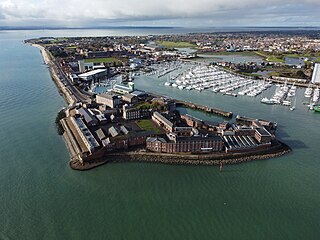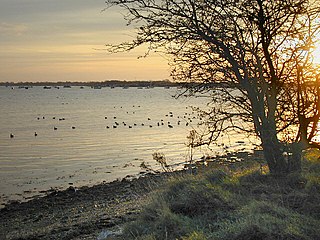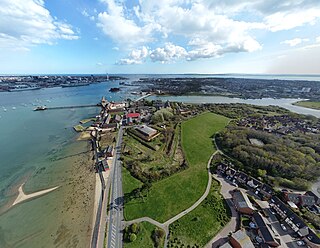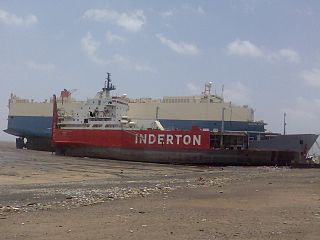
Portsmouth is a port and island city with unitary authority status in the ceremonial county of Hampshire, southern England. It is the most densely populated city in the United Kingdom, with a population last recorded at 238,800. Portsmouth is the only island-city in the United Kingdom. The city forms part of the South Hampshire built-up area, which also incorporates Southampton, Havant, Waterlooville, Eastleigh, Fareham, and Gosport. Located mainly on Portsea Island, Portsmouth is located 19 miles (31 km) south-east of Southampton and 70 miles (110 km) south-west of London.

Gosport is a town and non-metropolitan borough on the south coast of Hampshire, South East England. At the 2011 Census, its population was 82,662. Gosport is situated on a peninsula on the western side of Portsmouth Harbour, opposite the city of Portsmouth, to which it is linked by the Gosport Ferry. Gosport lies south-east of Fareham, to which it is linked by a Bus Rapid Transit route and the A32. Until the last quarter of the 20th century, Gosport was a major naval town associated with the defence and supply infrastructure of Her Majesty's Naval Base (HMNB) Portsmouth. As such over the years extensive fortifications were created.

Fort Blockhouse is a military establishment in Gosport, Hampshire, England, and the final version of a complicated site. At its greatest extent in the 19th century, the structure was part of a set of fortifications which encircled much of Gosport. It is surrounded on three sides by water and provides the best view of the entrance to Portsmouth Harbour. It is unique in two respects. Firstly, it was built over five centuries from its original construction as a blockhouse in 1431 to the final addition of submarine base structures in the mid 1960s. Secondly, it is thought to be the oldest fortified position in the United Kingdom that is still in active military use though coastal fortification was abolished nationally in 1956, and it has been used only for medical purposes since 2020.

Portsmouth Harbour is a 1,264.2-hectare (3,124-acre) biological Site of Special Scientific Interest between Portsmouth and Gosport in Hampshire. It is a Ramsar site and a Special Protection Area.

The Solent Way is a 60-mile (97 km) long-distance footpath in Hampshire, southern England. With the exception of a few inland diversions, the path follows the coast of the Solent, the sea strait that separates the mainland from the Isle of Wight. The Solent Way forms part of the E9 European Coastal Path, which runs for 5000 km (3125 miles) from Cape St Vincent in Portugal to Narva-Jõesuu in Estonia.

Stokes Bay is an area of the Solent that lies just south of Gosport, between Portsmouth and Lee-on-the-Solent, Hampshire. There is a shingle beach with views of Ryde and East Cowes on the Isle of Wight to the south and Fawley to the south west. The settlement of Alverstoke is close by.

Langstone Harbour is a 2,085.4-hectare (5,153-acre) biological Site of Special Scientific Interest in Hampshire. It is an inlet of the English Channel in Hampshire, sandwiched between Portsea Island to the south and west, Hayling Island to the south and east, and Langstone to the north. It is part of Chichester and Langstone Harbours Ramsar site, Special Protection Area and Nature Conservation Review site, Grade I. Parts of it are in Solent Maritime and Solent and Isle of Wight Lagoons Special Areas of Conservation. Three areas are Local Nature Reserves, Farlington Marshes West Hayling and The Kench, Hayling Island. Two areas are nature reserves managed by the Hampshire and Isle of Wight Wildlife Trust, Farlington Marshes and Southmoor Nature Reserve

Fareham railway station is on the West Coastway Line situated about 0.62 miles (1 km) from the town of Fareham in Hampshire, England. It is 84 miles 21 chains (135.6 km) down the line from London Waterloo.

St Vincent College is a co-educational sixth form (16-18) college located in Gosport, Hampshire, England. The majority of students come from the surrounding towns including Gosport, Fareham, Stubbington and Winchester. The nearby Gosport Ferry link with Portsmouth also allows students from that city to attend. The college has around 1,200 full-time students; it also caters for older "Access" students.

Priddy's Hard is a former military installation in Gosport, England. The site originated as a 1750s fort, and then became an armaments depot for Royal Navy and British Army weapons, explosives and other stores. The site was decommissioned in 1988, after over two hundred years of operation, with part now being developed for housing and an area retained as a museum.

The Nautical Archaeology Society (NAS) is a charity registered in England and Wales and in Scotland and is a company limited by guarantee.

Martin Snape was an English painter of the Victorian and Edwardian era.
Portsmouth is an island port city situated on Portsea Island in the county of Hampshire, England. Its history has been influenced by its association with the sea, and its proximity to London, and mainland Europe.

A ship graveyard or ship cemetery is a location where the hulls of scrapped ships are left to decay and disintegrate, or left in reserve. Such a practice is now less common due to waste regulations and so some dry docks where ships are broken are also known as ship graveyards.
The Maritime Archaeology Trust is a charitable trust that researches and excavates maritime archaeology and heritage in Great Britain. Historically, their core activities were focused around Hampshire, the Isle of Wight and the Solent, but now they work in other parts of the country and on international projects.
Defence Munitions Gosport is a defence munitions site which is situated on the south western shores of Portsmouth harbour, southeast of Fareham in Hampshire. The site occupies about 470 acres. DM Gosport facilities include two Integrated Weapon Complexes (IWCs), 24 processing rooms and 26 explosives stores. The site employs some 270 staff.

Vadne was a ferry built by Vosper & Company in 1939 for the Port of Portsmouth Steam Launch & Towing Company. In service until 1966, her remains are at Forton Lake, Gosport.

Forton Barracks was a military installation near Gosport in Hampshire, which served first as an Army barracks and then as a divisional headquarters for the Royal Marines. It subsequently served as a Royal Navy training establishment. Today, the site is occupied by St Vincent College.

Clarence Barracks was a military installation at Portsmouth, Hampshire.



















